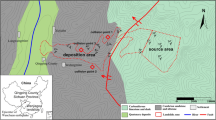Abstract
In order to further understand the mechanism of landslide-debris flow and predict the entire movement process and accumulation range of landslide hazards, the movement process of non-cohesive particles and the distribution of accumulation at the bottom of the slope were studied. Firstly, physical laboratory-scale tests on the sliding accumulation process of non-cohesive granular accumulations under self-weight were carried out, and the effects of different volumes and gradations on the sliding accumulation were analyzed. Then, the discrete element software PFC3D was used to perform three-dimensional numerical back analysis of the tests to refine the key parameters required for the numerical simulation, and to understand better the movement and accumulation state of the granular body. The results showed that the spherical particles exhibit obvious lateral expansion during the acceleration stage, and the front-end particles had a clear "shuttle" distribution, which became even more obvious with the increase in the content of large particles. The reverse-order phenomenon of spherical particles after sliding was that the proportion of small particles in the proximal end was far higher than their original proportion in the accumulation body. With the increase in the volume of the accumulation body, the phenomenon became more obvious, and stopping of large particles above the small particles was observed. The research results can provide reference for further studies of the movement process and the distribution patterns of the slip instability failures of non-cohesive accumulation bodies.
























Similar content being viewed by others
References
Chiaming L, Minglang L, Chaolung T et al (2011) A kinematic model of the Hsiaolin landslide calibrated to the morphology of the landslide deposit. Eng Geol 123(1):22–39
He S-M, Bai X-Q, Ouyang C-J, Wang D-P (2017) On the survey of giant landslide at Xinmo village of Diexi Town, Maoxian Country, Sichuan Province. China Mount Res 35(04):598–603
Huang H-Q, Zhao Q-H (2010) Basic characteristics and preliminary mechanism analysis of large scale rockslide-sturzstrom at Wenjiagou triggered by Wenchuan earthquakes. J Eng Geol 18(02):168–177
Hutter K, Koch T (1991) Motion of a granular avalanche in an exponentially curved chute: experiments and theoretical predictions. Philos Trans R Soc Lond Ser A 334(1633):93–138
Ji X-J, Ou G-Q, Yang S, Wang J, Lu G-H (2013) Comparison analysis of the motion process about viscous and no-viscous landslip-collapse soil based on PFC3D. J Sichuan Univ (Eng Sci Edn) 45(S1):67–73
Manzella I, Labiouse V (2008) Qualitative analysis of rock avalanches propagation by means of physical modelling of non-constrained gravel flows. Rock Mech Rock Eng 41(1):133–151
Ma Y, Wu Y-F (2011) "8·13" Extra large debris flow disaster in Wenjia gully of Qingping Township, Mianzhu, Sichuan Province. Chin J Geol Hazard Control 22(01):21
Pudasaini SP, Hsiau SS, Wang Y, Hutter K (2005) Velocity measurements in dry granular avalanches using particle image velocimetry technique and comparison with theoretical predictions. Phys Fluids 17(9):093301
Ren J-W, Shan X-J, Shen J, Sang Ge, Sang Z, Deng G-Y et al (2001) The geomorphology and kinematics of the Yigong collapse-landslide-debris flow in Tibet. Geol Rev 06:642–647
Sun G-H, Lin S, Zheng H, Tan Y-Z, Tan S (2020) The virtual element method strength reduction technique for the stability analysis of stony soil slopes. Comput Geotech 119:103349
Xu Q, Li W-L, Dong X-J, Xiao X-X, Fan X-M, Pei X-J (2017) The Xinmocun landslide on june 24, 2017 in Maoxian, Sichuan: characteristics and failure mechanism. Chin J Rock Mechan Eng 36(11):2612–2628
Yang Q-Q, Fei C, Ugai K, Yamada M (2011) Some factors affecting the frontal velocity of rapid dry granular flows in a large flume. Eng Geol 122(3/4):249–260
Zhang L, Tang H-M, Xiong C-R, Huang L, Zou Z-X (2012) Movement process simulation of high-speed long-distance Jiweishan landslide with PFC3D. Chin J Rock Mechan Eng 31(S1):2601–2611
Acknowledgements
This research was supported by National Natural Science Foundation of China (51179043).
Author information
Authors and Affiliations
Corresponding author
Additional information
Publisher's Note
Springer Nature remains neutral with regard to jurisdictional claims in published maps and institutional affiliations.
Rights and permissions
About this article
Cite this article
Lu, K., Chen, Y. & Wang, L. A study on the motion and accumulation process of non-cohesive particles. Nat Hazards 105, 205–225 (2021). https://doi.org/10.1007/s11069-020-04305-0
Received:
Accepted:
Published:
Issue Date:
DOI: https://doi.org/10.1007/s11069-020-04305-0




